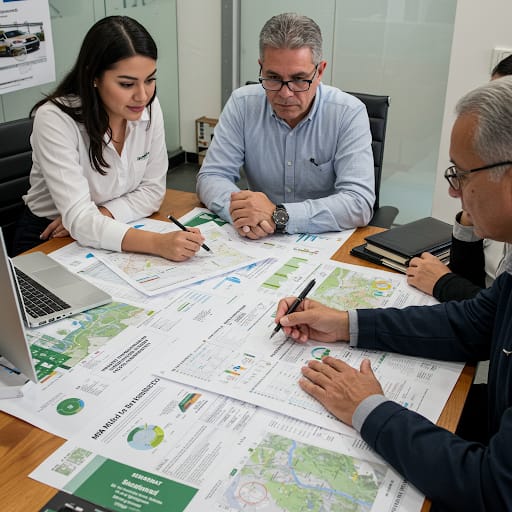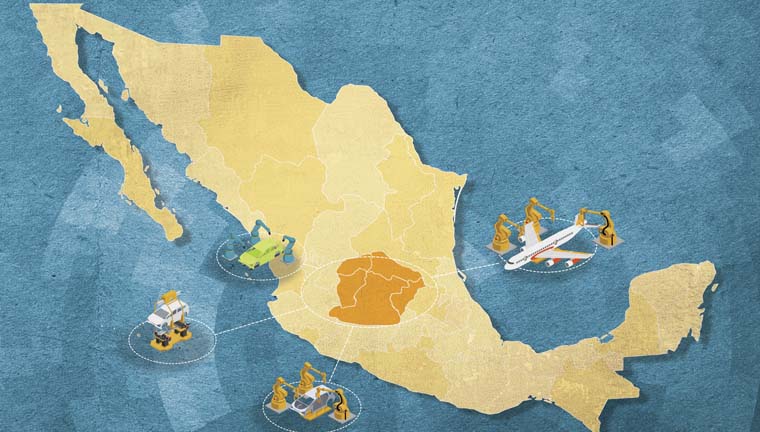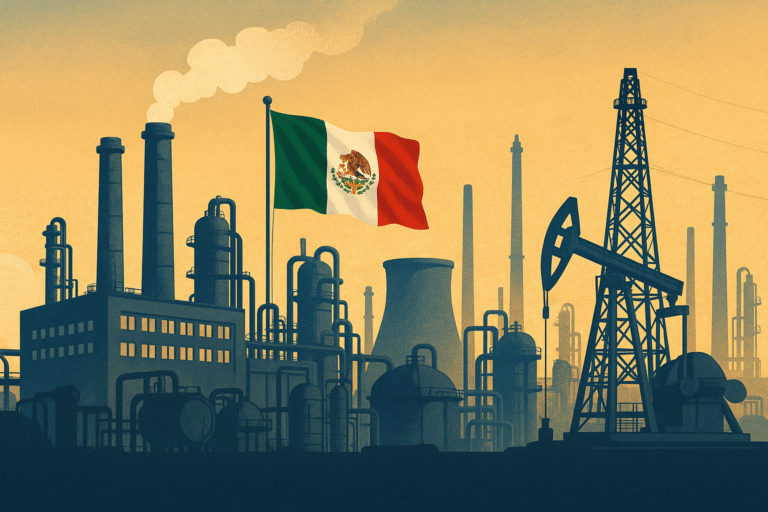Environmental Impact Assessment (Manifestación de Impacto Ambiental – MIA)
Authors: Miriam Paola Sotelo Damian and Oswaldo Aldair Rea Valladares
Keywords:
- Environmental Impact: The modification of the environment caused by natural forces or human activities.
- Ecological Imbalance: Refers to the biological instability resulting from the disruption of elements that constitute, participate in, and maintain the stability of the environment.
- Environmental Policy: Declares the objectives and principles related to the environment.
- Manufacturing: The activity of the secondary sector of the economy, related to industrial production.
- Infrastructure: The set of elements or services necessary for the proper functioning of a country, society, or organization.
- Environmental/Ecological Resilience: The ability of an ecosystem to recover from sudden or violent changes in its habitat, returning to normal once these changes cease.
- Synergistic Impact: Occurs when the combined effect of the simultaneous presence of several agents results in a greater environmental impact than the sum of their individual impacts considered separately.
- Ecosystem Fragmentation: The process of dividing a continuous habitat into sections. A habitat is the environment occupied by a population and can be a forest, stream, sand dunes, or pond.
Objectives:
To understand the importance of preparing an Environmental Impact Assessment (MIA) to prevent activities that could potentially harm the environment.
Summary:
The Environmental Impact Assessment (MIA) is the document through which SEMARNAT (Ministry of Environment and Natural Resources) and state governments evaluate the environmental impact of works and activities that may cause ecological imbalance or exceed the limits and conditions established in applicable regulations to protect the environment, preserve ecosystems, and restore them, aiming to avoid or minimize their negative effects on the environment.
Based on research and technical analysis, the MIA discloses the significant and potential environmental impacts that a project or activity may have and outlines methods to avoid or mitigate these negative impacts. Depending on the nature of the project, the relevant environmental study is submitted to the state or federal agency responsible for its evaluation.
Introduction:
Legally, environmental impact refers to the modification of the environment caused by human activities or natural forces.
An environmental impact report is a scientific and technical study that shows the potential impact of a project or activity on the environment and identifies preventive measures to reduce its negative effects. This study can assess the environmental feasibility of industrial, infrastructure, manufacturing, commercial, or service investment projects. The federal environmental impact report is submitted to SEMARNAT for evaluation and possible approval or to the state environmental agency (e.g., SMAOT in Guanajuato). When a project or activity is approved, the Federal Attorney for Environmental Protection (PROFEPA) or the state environmental agency (e.g., PAOT in Guanajuato) must verify compliance with the established terms and conditions.
For the development of the MIA, individuals (natural or legal persons) planning to carry out works or activities must analyze and describe the environmental conditions before the project’s execution to identify and evaluate the potential impact of construction and operation on the environment. They must also determine and propose the necessary measures to prevent, mitigate, or compensate for these changes.
To achieve a positive effect on the environment, it is essential to understand the extent of degradation caused by certain actions. Therefore, it is important to evaluate and understand the negative effects (e.g., increased CO2 levels) and discern which environmental components would be affected. The MIA is a tool for generating environmental information, as constant changes in the environment can be both positive and negative. However, anthropogenic activities are considered the primary threat to the conservation of natural resources.
The Environmental Impact Assessment (MIA) is a scientific-technical study of environmental policy aimed at preventing, mitigating, and restoring environmental damage, as well as regulating works or activities to avoid or reduce negative effects on the environment and human health.
Development:
The LGEEPA (General Law of Ecological Balance and Environmental Protection) defines environmental impact as changes in the environment caused by human or natural activities. It also states that ecological imbalance is a change in the interdependence of natural elements that make up the environment, negatively affecting the existence, transformation, and development of humans and other organisms. It further defines the Environmental Impact Statement (MIA) as a document that, based on research, reveals the significant and potential environmental impacts of a project or activity and the ways to avoid or mitigate them if they are negative.
The MIA has been established as an instrument of environmental policy, analytical and preventive in nature, allowing the integration of a set of projects into the environment and, consequently, a specific plan or program to offer advantages to both the environment and the project to be carried out. These advantages are reflected in designs that are more integrated with the environment.
The study involves the collection of information and consultation of authorized sources to obtain evidence of the project’s potential to generate alterations. It also includes a study on the environmental carrying capacity within and around the area where the project will be located.
The law defines environmental impact as a change in the environment caused by human or natural activities. Therefore, the environmental impact assessment process considers the following objectives:
- To ensure that productive activities achieve the least possible deterioration of the environment.
- To identify the negative impacts of the project on the environment and apply technical mechanisms to avoid or reduce them.
- To generate elements for responsible and competent authorities to choose project alternatives that cause minimal environmental costs.
To obtain SEMARNAT’s authorization, an Environmental Impact Statement must be submitted in the appropriate modality so that SEMARNAT can evaluate the project or activity for which authorization is requested.
SEMARNAT provides guidelines to facilitate the submission and delivery of the Environmental Impact Statement, depending on the type of project or activity to be carried out. These can be:
- Preventive Report
- Environmental Impact Statement, Particular Modality
- Environmental Impact Statement, Regional Modality (Article 28 of the LGEEPA).
Regional Modality applies to:
- Industrial parks, farms larger than 500 hectares (ha), highways, and railways.
- A set of works or activities included in an urban development plan or program.
- A set of works and activities to be carried out in an ecological region.
- Projects to be developed in areas where, due to their interaction with various regional environmental components, cumulative impacts could cause ecosystem fragmentation.
Particular Modality refers to all other cases not included in the Regional Modality. In this case, the MIA is for projects that have an impact on a focal area, without influence on basins or large-scale ecosystem networks.
Why is the MIA Important for Your Business?
If your company is planning to establish or expand operations in Mexico, particularly in states like Querétaro or Guanajuato, understanding the Environmental Impact Assessment (MIA) is crucial. The MIA is more than just a regulatory requirement—it’s a commitment to sustainable development and environmental stewardship. By completing the MIA process, your company can:
- Ensure Compliance: Avoid legal penalties and project delays by meeting all regulatory requirements.
- Protect the Environment: Minimize your project’s environmental footprint and contribute to the preservation of Mexico’s natural resources.
- Build Trust: Demonstrate your commitment to sustainability, which can enhance your reputation with stakeholders, investors, and local communities.
- Reduce Risks: Identify potential environmental risks early and implement measures to mitigate them.
How CAPSIA Can Help
At CAPSIA, we understand that navigating the MIA process can be complex and time-consuming. Our team of experts is here to guide you every step of the way, from preparing the necessary documentation to liaising with SEMARNAT and ensuring ongoing compliance. With our deep knowledge of Mexican environmental regulations and extensive experience in EHS consulting, we can help your company establish or expand operations in Mexico with confidence.
Conclusion:
The Environmental Impact Statement seeks to ensure the balance and integrity of the environment after the implementation of the system (process) in the best possible way.
The direct purpose of the environmental impact assessment is to assist in decision-making. For this, its results must be presented in a logical sequence, objectively and comprehensibly, so that the evaluator analyzing the document can support the institution’s decision on whether the project is suitable to proceed. In addition to identifying, preventing, and explaining the potential environmental impacts of the project, the main objective of the MIA is to define and recommend a set of mitigation measures to reduce, compensate, or even eliminate these impacts.
If you’re ready to take the next step, contact CAPSIA today to learn how we can support your project. Visit our website at capssia.com or reach out to our team directly. Let CAPSIA be your trusted partner in navigating Mexico’s regulatory landscape and achieving sustainable growth.
References:
References:
- PROFEPA (Federal Attorney for Environmental Protection)
- What is the Environmental Impact Assessment (MIA)?
Available at: https://www.gob.mx/profepa/articulos/manifestacion-de-impacto-ambiental-mia
- What is the Environmental Impact Assessment (MIA)?
- SEMARNAT (Ministry of Environment and Natural Resources)
- Guide for the Preparation of the Environmental Impact Assessment in its Regional Modality (2019)
Available at: http://dsiappsdev.semarnat.gob.mx/formatos/DGIRA/Guia_MIA-R-DIC-2019.pdf
- Guide for the Preparation of the Environmental Impact Assessment in its Regional Modality (2019)
- SEMARNAT (Ministry of Environment and Natural Resources)
- Content of an Environmental Impact Assessment
Available at: https://www.gob.mx/semarnat/acciones-y-programas/contenido-de-una-manifestacion-de-impacto-ambiental
- Content of an Environmental Impact Assessment
- Government of Guanajuato
- Technical Standard for Environmental Impact
Available at: https://transparencia.guanajuato.gob.mx/biblioteca_digital/docart10/200804291013220.Norma%20Tecnica%20Impacto%20Ambiental.pdf
- Technical Standard for Environmental Impact
- Government of Querétaro (SEDESU)
- Information on the Environmental Impact Assessment
Available at: https://www.queretaro.gob.mx/sedesu/contenido.aspx?q=0P7NpIeTMwxyRqgPw8OEjUpBd+55d5rlAmo//qtcumo=
- Information on the Environmental Impact Assessment







